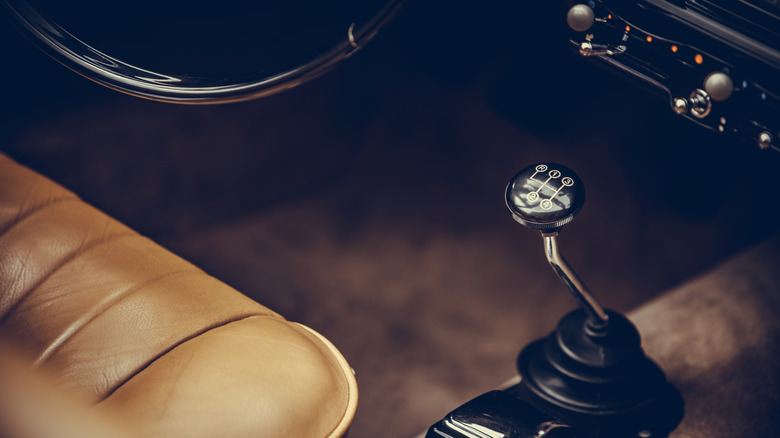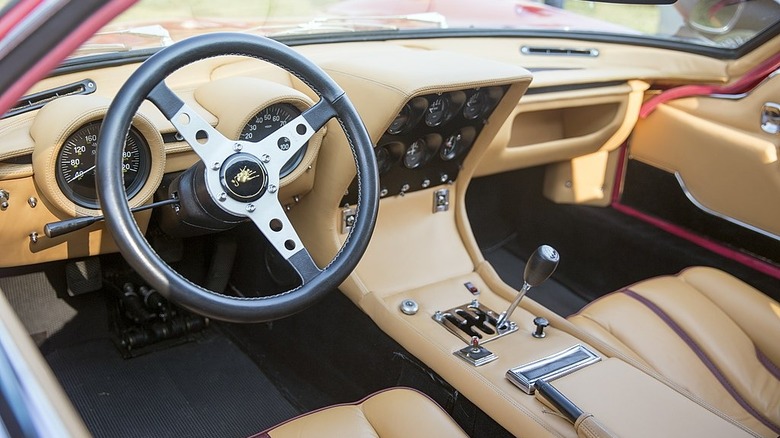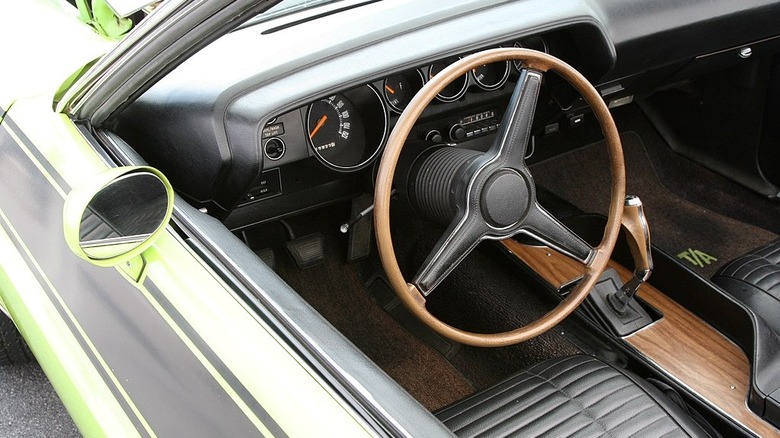6 Of The Coolest Gear Shifters In Classic Cars
There's something about a gear shifter that brings the cool factor of a car to another level. The mixture of looks combined with what you know it's connected to in order to deliver more performance is a thing of beauty and joy.
Mind you, we're not talking about modern, high-performance, finger-flipping paddle shifters (which many people think is the most pointless car feature). We're talking about old-school shifters you have to grab hold of. Whether it's a pistol grip or lightning rods, sitting four on the floor, sticking out of the steering column, or somewhere else entirely. Heck, it doesn't even matter if it's an automatic, gated, or standard transmission — a cool shifter is the thing that inexorably bonds the driver to the vehicle.
What exactly defines a classic car is, much to no one's surprise, all over the map. And based on the state you're living in, there can be all sorts of exceptions. Some people believe a car must be at least 25 years old, which just so happens to coincide with the age limit for a motor vehicle to lawfully be imported into the U.S., even if it doesn't comply with Federal Motor Vehicle Safety Standards (FMVSS).
However, most groups (including insurance companies) deem a "classic" to be 20 years or older until they reach the "antique" stage, and that's a whole different topic. For simplicity's sake, our list of sticks will stick (pardon the pun) with any car (foreign or domestic) that's at least 20 years old.
General Motors Horseshoe Ratchet
Most enthusiasts are all about the "H" shaped gear shift pattern, but we weren't kidding about shifters for automatics being cool, too, because we're starting this list off with one. Say hello to the Horseshoe Ratchet found in late model Chevy Chevelles, Camaros, Monte Carlos, and Impalas.
The floor sitting shifter only moves back and forth on a rail, shifting in sequence from (bottom to top) — 1st, 2nd, 3rd, Neutral, Reverse, and Park. Sure, there are issues with how it actually performs, particularly in that the original equipment shifter doesn't exactly provide a positive stop at each gear. Unfortunately, this frequently causes the driver to shift past the gear they wanted, sometimes even sliding all the way into Neutral before it stops at Reverse.
Whatever, this isn't a list of best-performing shifters. Plus, it's a problem that can easily (and cheaply) be fixed with an after-market ratchet-shift detent plate that'll give it true "slap-shift" capability that properly stops at each gear. Despite that hiccup, the Horseshoe Ratchet still looks fantastic and makes you feel like you're engaging the throttle in a fighter jet or spaceship. Yes, that's really something men dream about while operating their far less glamorous four-wheeled rides.
Gated Manual
According to those who have driven a high-performance supercar with a gated manual transmission, the experience will change your life. The idea behind the gates is akin to training wheels on a bike — to help drivers sink home the gear shifter in otherwise notoriously tricky and intolerant transmissions. No one wants to ruin a perfectly good transmission in one of those expensive beasts.
The milled gates on the shifter offer almost error-proof shifting, as the design makes it difficult to put it into the wrong gear unintentionally. The tactile feel and mechanical click given off by a gated shifter when it slides into place are allegedly unparalleled. Aesthetically, the gate itself typically looks as if it was honed from a solid piece of aluminum and enhances the car's interior. When seen by other car enthusiasts, it consistently garners respect.
In this case, we look to the Miura, which was Ferruccio Lamborghini's attempt to best Enzo Ferrari's 350 GT. In the process, Lamborghini made the first (and fastest) standard production car in the world. The history of gated shifters goes back to the mid-20th century, so the Miura isn't the first or only car to have a gated transmission. Certain Ferraris (such as the F355, one of the greatest supercars of all time), Audis, and even Aston Martins use them, as do Lamborghini's Countachs, Diablos, and Gallardos.
[Featured image by Mr.choppers via Wikimedia Commons | Cropped and scaled | CC BY-SA 3.0]
Cord Preselector
Unless you're a diehard car junkie, it's unlikely that you've heard of Cord automobiles or preselector gearboxes — none of which disqualifies it from being one of the most incredible, elegant, and simultaneously confounding (to our modern minds especially) shifters on the list.
The gearboxes found in Cord cars from the 1930s were semi-automatic preselector shifting transmissions. A shiny gizmo sat on the end of a stalk coming off the steering column that was, in essence, a miniature version of a gated shifter that guided the tiny shift lever.
It sat close enough to the steering wheel that the driver could use fingers to move the shift lever when needed. Which, if you think about it, is close to an early version of a paddle shifter. But instead of shifting gears like we're familiar with today, Cord's Preselector worked much differently.
Instead of depressing the clutch and then shifting, this old-timey predecessor to today's transmissions operated by first preselecting the gear you wanted to shift into by moving the lever to the appropriate gear slot, and only after depressing the clutch would it automatically shift into that preselected gear. This was accomplished via electrical signals (from the gear shifter) sent to a pneumatic system that changed the gears.
Cool enough for you?
Hurst Lightning Rods
If you thought the Cord preselector was funky, hold on for Hurst's Lightning Rods. Hurst is a company known for its shifter-making prowess, and it won't be the only time you hear it on this list. In 1983, Oldsmobile teamed up with Hurst to unleash a limited edition G-body Cutlass that hearkened back to the American muscle car era. The Hurst/Olds was worth every penny and equipped with a three-headed shifter that brought the thunder — Lightning Rods!
In essence, Hurst took its sequential shifting Dual Gate shifter from the late 60s and, thinking that more is better, came up with an automatic transmission that basically gave the driver a stick for every gear. The far-left shifter engaged Park, Reverse, Neutral, and Drive, while the middle stick handled going from second to third, and the far right shifted from first to second.
The idea was designed for drag racing because shifting in a straight line instead of in a standard H pattern is faster, but everyone involved here thought providing it to the masses would be neat, and drivers would be less inclined to grab the wrong stick. To be sure, it looked much cooler than it actually performed, but that didn't stop Hurst from trying to get it into other four-speed automatic GM products like the Camaro and the Firebird.
Citroën SM Open Barrel
When Citroën unveiled the SM at the Geneva auto show in 1970, to call it weird — even in the 70s — was not hyperbole. The "SM" stands for System Maserati (of sports car fame), which the French company had just bought. Based on its long-standing DS line, it was meant to be a high-end grand touring coupe.
Among its odd features was a hydro-pneumatic suspension (technology that was far ahead of its time) using pump-driven hydraulic fluid and bladders filled with nitrogen at each wheel. The system allowed for adjustable ride height and could load level automatically, giving one of the softest rides available. It was so good, Rolls-Royce licensed it.
The aerodynamic, cigar-shaped body was sleek and tapered towards the back, making the rear some eight inches narrower than the front. The V6 Maserati engine was mounted backward behind the front axle, while the transmission was pointed towards the front ahead of the engine.
All quirkiness aside, the Citroën SM was the fastest front-wheel drive car (with a reported top speed of 140 mph) in 1972 and was named Motor Trend's "Car of the Year," besting two German rivals — Porsche's 911S and BMW's Bavaria.
Hurst Pistol Grip
Finally, we come to what is arguably the coolest shifter of all time: the Hurst Pistol Grip. Our fascination with the Old West and cowboys (and their affinity for their pistols) may lie at the heart of this obsession. It was almost a piece of art, with its sculpted contours and indents for your fingers that transferred the engine's rumble directly into the palm of your hand. It just felt right.
Before releasing the 1970 Dodge Challenger and Plymouth Barracuda models, Chrysler teamed up with Hurst to create what would become the iconic shifter. In fact, every Dodge and Plymouth B and E body models between 1970 and 1974 that were ordered with a four-speed came standard with the pistol grip. This included the mysterious '70 Challenger known as the "Black Ghost" that became a legend on the streets of Detroit.
Sadly, once the muscle car era died, the pistol grip went the way of the dodo bird and vanished. It remained part and parcel of a bygone era until Hurst re-issued its line of pistol grip handles and shifter sticks in 2007. Today, they can be purchased in various styles made with different materials and features (even automatic transmissions), so almost everyone can experience that same feeling.
[Featured image by Triple-green via Wikimedia Commons | Cropped and scaled | CC BY-SA 3.0]


